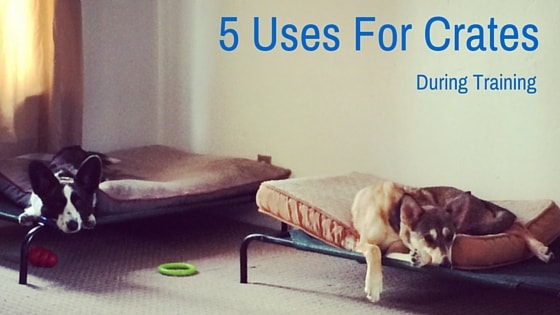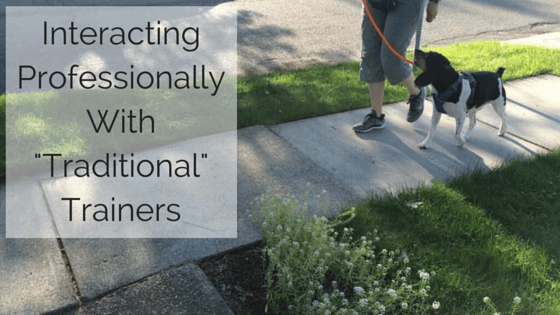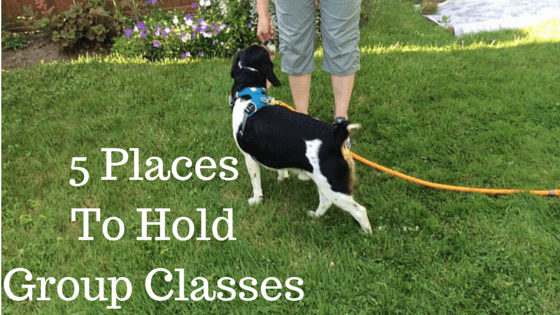![5 Uses For Crates During Training]()
by Liz Wyant | Jan 6, 2015 | Training Methods

Many clients are averse to the idea of crating their dogs. Being able to explain to them how crating can help their dog’s training progress may open them up to the concept.
Housetraining
Crating can be of immense benefit when it comes to housetraining a dog, regardless of age. It keeps the dog confined to a relatively small space, keeping them from being able to roam and squat wherever they desire. Feeding the dog in the crate makes housetraining go even faster as most dogs will not go to the bathroom where they eat. Obviously it is important to stress to your clients the importance of taking the dog outside on a regular basis. Also, be sure to emphasize that crating is not to be utilized 24/7, but only when the dog is not able to be immediately supervised.
Settle
Crating can teach a dog that it’s okay to relax. Starting with very small amounts of time, clients can put their dogs in a crate with something yummy to chew on. Doing this consistently can teach the dog that good things happen in there and it’s okay to relax and settle down. This can be helpful at times when visitors are coming and going or the dog just needs to be out of the way for some reason. Having a dog that will settle in its crate can be a great management tool.
Home Base
Group classes are a great time to utilize crating. When you are talking and your attendees need to listen, they can put their dog (who knows that settling in a crate is a good thing!) in the crate so they can focus on you. The crate can also act as a home base for the dog when things get stressful or he just needs a break. Or make a training game of it – have your client do some work with the dog and then they and their dog can run to the crate together and throw a party when the dog enters.
Separation Distress/Anxiety
Separation distress/anxiety can be a nightmare to deal with, but crating can sometimes help ward it off. If your client’s dog has learned to associate the crate with Very Good Things, and has learned that its crate is used for settling in and relaxing, it can help the process of treating the separation anxiety. It is also useful to prevent a dog from pacing back and forth from window to window and barking at people/animals passing by, thereby keeping their stress levels elevated. Crating can encourage the dog to just relax and sleep or work on a chew toy. Note: Separation anxiety can be dangerous for the dog – if you are not confident in your ability to recommend a course of action that will keep the dog safe during training, please refer your client to somebody who is!
Preparation For Emergencies
Nobody ever wants a tragedy to occur, but sometimes they do. What happens if your client’s dog gets sick and has to spend the night at the e-vet? If the dog isn’t accustomed to crating, it can get incredibly stressed out, hindering treatment. If you and your clients live in a location with natural disasters that might prompt evacuation, having a crate trained dog can make it much easier to find a place that a client can go with their dog. Or even something as basic as your client wanting to take a vacation – dogs that are not accustomed to crating are more likely to panic in a kennel setting.
Crating responsibly can be incredibly beneficial to your clients’ progress in training their dogs. Being able to explain the usefulness may open some otherwise closed minds.
Get Dog Training Business Tips!
Receive valuable dog training business tips and resources every week! Subscribe to The Modern Dog Trainer now by submitting your name and email below.
[mc4wp_form]
![5 Uses For Crates During Training]()
by Liz Wyant | Dec 4, 2014 | Events, Training Methods

Ken Ramirez, Liz Wyant (the author of this article), and some of her friends at his Cleveland seminar.
A Weekend With Internationally Recognized Animal Trainer, Ken Ramirez
Ken Ramirez has been in the animal training/behavior world for over 35 years. He has worked with guide dogs, law enforcement K-9s, zoo animals, and marine animals. He has worked at Chicago’s Shedd Aquarium for 26 years, most recently as the training advisor. In October of 2014, he started a new role as the Executive Vice-President and Chief Training Officer of Karen Pryor Click Training. Ken is an avid proponent of force-free animal training.
In November, Ken presented a two-day seminar we were able to attend. 26 pages of notes later, here are some of the concepts we felt were most important.
Training 101
Ken describes training as teaching an animal what the rules for living in a particular space are. He emphasizes that it should be a shared process; the animal should WANT to be with that person and should WANT to train.
Ken feels the cornerstones of animal care are:
- Health Care
- Nutrition
- Environment
- Behavior Management – As Ken says repeatedly, “training is not a luxury.”
That last point is what struck me the most – training is not a luxury. So often our clients factor in costs of health care, food, and grooming, but not training. Training is only used when something goes bad, not to provide the mental stimulation that dogs need to have a basic, happy and healthy life.
Least Reinforcing Scenario/Stimulus (LRS)
Ken explained the LRS as the most positive approach to dealing with unwanted behavior. It was developed in the zoological training community as a way to operationalize the mantra of “ignore the unwanted behavior.” Though very basic, it can be a powerful tool. The Least Reinforcing Scenario is simply a 2-3 second neutral response after an animal gives an unwanted behavior, followed immediately by another opportunity to earn reinforcement. For example, you cue a dog to sit and it lies down instead. Immediately when the dog lies down instead of sits, give a neutral response for 2-3 seconds and then cue the dog to do a different cue that you are positive they can successfully complete.
So what is a neutral response? There is no straight answer to this. It is not a freeze, it is just a continuance of what you are doing – if you are looking at the dog, keep looking at the dog. If you were in the process of scratching an itch, keep scratching the itch. The key is to just maintain the environment so the dog is neither punished nor rewarded. This is only effective for a dog that is accustomed to working in a positive reinforcement environment. When you reward, reward, reward and then don’t, the dog will notice the lack of rewarding. There’s no need to extend the time or get emotional – just 2-3 seconds of a neutral response is enough feedback.
Alternative Reinforcers
Alternative reinforcers are learned reinforcers. They can be anything – clapping, toys, touch, play, words, or anything else the animal values. They give you a chance to provide some variety in your reinforcers to keep the dog excited about working with you. Alternative reinforcers need to be trained as behaviors so the dog understands what they mean. This means it needs to be paired with food and marker signals and practiced for weeks. Once the dog begins to value the alternative rewards, you should still use treat rewards 80% of the time during training sessions.
For alternative reinforcers to be effective, the trainer and animal must already have a predictable and solidly established relationship. It is incredibly important to constantly maintain the strength of the alternative reinforcer by keeping it paired with food. Also, be mindful that if a dog’s behaviors deteriorate after using the alternative reinforcer, the alternative reinforcer is NOT a reinforcer at all!
These are just a few of the topics that Ken discussed. He kept everybody captivated for two full days and we left feeling invigorated about training and ready to try his ideas. Should you get the opportunity to see him, we couldn’t recommend him highly enough!
Have you tried using LRS’s or alternative reinforcers? Tell us in the comments!
Get Dog Training Business Tips!
Receive valuable dog training business tips and resources every week! Subscribe to The Modern Dog Trainer now by submitting your name and email below.
[mc4wp_form]
![5 Uses For Crates During Training]()
by Liz Wyant | Dec 2, 2014 | Communication

Interacting Professionally Online and In-Person With A Variety Of Dog Trainers
Traditional trainers (those who introduce physical corrections into their training of some sort) are as passionate about their training methods as force-free trainers are about their methods. Unfortunately, this can often cause confrontations when the two types of trainers come together, either in person or via the internet. Arguing is stressful and non-productive, so what are some options for gracefully handling these interactions?
(As an aside, the vast majority of traditional trainers are not interested in arguing and being rude to force-free trainers – this article is to help when dealing with the small minority that revel in being hostile.)
Turn The Other Cheek
Often traditional trainers start slinging around names and insults to rile up force-free trainers. Though it can be frustrating, you should try to ignore this. On the other hand, take the higher ground and do not reciprocate by throwing derogatory terms and names back at them.
Don’t Get Pulled In
Sometimes the easiest option is to walk away. If you know that you are not going to be able to retain your composure whilst discussing your side, give yourself the power to remove yourself. Getting riled up is not going to affect the other person. It will simply make you miserable and possibly reflect badly on your reputation.
Agree To Disagree
Often you just reach a point in conversations where the discussion is going in circles. Your mind is not going to change and neither is their’s. At this point, agree to disagree. Continuing the conversation is going to accomplish nothing other than to annoy you and waste your time. Ending the conversation this way will preserve your sanity and reputation.
Know Your Facts
Before getting involved in discussions, make sure you know your facts. Be prepared to cite books, articles, and other reputable resources that show the power of positive reinforcement. If you are confident about your training methods and why you use them, having the resources to back up your arguments will be helpful.
Above all, remember that positive reinforcement works for people, too. So often, force-free trainers are so passionate about their techniques that they get riled up and lash out when challenged. Arguing will not change minds. Use your personal dogs and the dogs you train as good examples of the power of force-free training. Always keep in mind that everyone is working towards the same goals, you are just pursuing different pathways to get there.
What do you recommend for interactions with traditional trainers who want to argue?
Get Dog Training Business Tips!
Receive valuable dog training business tips and resources every week! Subscribe to The Modern Dog Trainer now by submitting your name and email below.
[mc4wp_form]
![5 Uses For Crates During Training]()
by Liz Wyant | Nov 13, 2014 | Business, Training Methods

When new clients contact you, generally the first thing you will be asked about is classes you offer. Most people don’t even think about private training. Knowing whether to guide your clients in the direction of classes or private sessions will help your clients get the most bang for their buck.
Reactive/Fearful Dog
Though there are some incredibly well-run “Reactive Rover” type classes out there, for dogs that cannot be in the same building/vicinity of other dogs or people, classes can just be too much and there will be little to no benefit. Help the client get a solid foundation on the dog through private sessions. If the dog and owner have zero foundation skills, they will struggle in a group class setting.
Young And/Or Untrained Dog
Beginner Obedience classes are probably the most utilized class out there, but are they always the best option? So often, the massive distraction of other dogs and people all combined make it difficult for a young or untrained dog to focus on their owner. Doing even one or two private sessions before putting a dog into a class can make a monumental difference in their ability to focus and benefit from the class.
Owner Needs Special Attention
There are some clients that, for a myriad of reasons, would benefit from one-on-one instruction. Putting an owner like this into a group class just wouldn’t be fair or beneficial to them. This type of owner craves your full attention which cannot be provided in a group class setting. Spend some time with them in private sessions so they can be confident in their abilities before you transition them into a group class.
Specific Training Issue
If you have a client that has attended group classes and continues to have problems getting his/her dog to do a certain behavior, a private session may be in order. This will enable you to focus all of your attention on them and see what the problem may be so you can help them fix it.
Household Issues
Housetraining, intra-household dog aggression, cat/dog issues – many of these are problems that can’t always be solved in a group class. These often require you to go to a client’s home and help them enact feasible management while they work on behavior modification.
What other times do you recommend private sessions versus group classes to your clients?
![5 Uses For Crates During Training]()
by Liz Wyant | Nov 8, 2014 | Business

If you are a dog trainer without your own private training facility, you can sometimes feel relegated to holding only private in-home sessions. However, with some creativity and planning, you can hold group classes in many different places.
Public Parks
Public parks can often provide you wide open spaces to hold group classes. They enable you to spread dogs out so even space-sensitive dogs can succeed. Holding group classes in parks is often easier if you have somebody to partner with so that one person can teach while the other can run interference with curious bystanders or loose dogs. Be sure to check any city regulations about using parks for personal gain.
Veterinary Offices
Many veterinary offices have spacious lobbies. They often love having a trainer “on staff,” so to speak, so they can refer clients to you. If you can establish a good working relationship with a vet, it can become mutually beneficial with each party referring potential clients to the other. Classes are a great way to keep clients coming back to their office and you’ll be able to make new relationships with clients.
Local Pet Stores
Most of the big box pet stores have their own staff trainers, but many local pet stores have decent open areas and would love to have a trainer hold group classes there to bring customers in their doors. If you promise to promote their products, they may even allow you to use the space for free. Additionally, holding group classes in a pet store provides for GREAT distraction training!
Parking Lots/Garages
Parking lots/parking garages can be fantastic for group classes. Being on concrete allows for distracted dogs to focus a little more easily, yet there is often still grass close by for potty breaks and sniffing rewards. Also, like public parks, they are very large and permit you to spread your clients out so all the dogs have ample space. Just make sure you have permission to be there.
Halls/Basements
Sometimes churches or AmVets type clubs will rent out their halls or basements for a reasonable fee. Be aware that some may require you to be an active member to get this benefit, but it certainly does not hurt to call around and ask.
Remember that when you are out in public or using somebody else’s space, it is important to leave the space as clean as or cleaner than it was when you arrived. Doing so ensures that you and your clients will always be welcome in the future.
What other places do you use for group training?
Recommended Links
![5 Uses For Crates During Training]()
by Liz Wyant | Nov 7, 2014 | Training Methods

Crate Training Can Seem Peculiar To Clients
For those unfamiliar with crate training, it can seem cruel, almost as if the dogs are being caged like zoo animals. However, as a savvy trainer, it is important to be able to explain to your clients a few reasons they should strongly consider crate training.
Know Where The Dog Is
Explain to your clients the great peace of mind that can come from knowing exactly what scene they will be walking into upon their arrival home – their dogs, happily wagging, safely contained in a crate, nothing in their home destroyed. Day after day, consistently.
Home Security Systems
Many people these days have home security systems. Remind your clients that if their alarm system goes off and the police are notified, the police WILL enter their home, with or without them present. Wouldn’t your clients rather know their dog is safely out of harm’s way due to being happily crate trained?
Windows = Automatic Dog Trainers
When dogs have access to windows during the day because they are free roaming, they can learn some valuable lessons. Valuable to them, at least. These include: barking scares the mail carrier away; barking scares pedestrians away; barking scares passing dogs away; barking scares delivery people away. That means your client’s dog has learned that barking excessively makes things go away. This is not really a lesson most people want their dogs to possess! Crate training keeps the dogs away from windows, preventing them from getting over-aroused multiple times throughout each day.
Learn To Relax
Dogs that are permitted to roam around the house, pestering the cats, barking out the windows, and finding other ways of entertaining themselves have a high probability of getting into trouble. Crate training teaches dogs to relax and enjoy downtime, especially when left with a lovely chew toy or work-to-eat toy in their crate.
No Issues With Other Household Animals
Many of your clients will be multi-pet owners. Whether those pets are all dogs, dogs and cats, dogs and birds, or some other combination, crate training ensures the safety of all animals in the household. Encouraging your clients to crate train means they will not ever have to be concerned about coming home to an injured or dead pet due to a fight that may have started over something as insubstantial (to people) as a tissue on the floor or play that escalated without supervision. Clients enjoy knowing that all of their beloved pets are safe and happy and will remain so.
Many clients may balk at the idea of crate training. Being able to calmly explain different benefits of it will enable them to start working through their antipathy towards the idea.
What are some other reasons you can think of to encourage crate training?
Recommended Links
![5 Uses For Crates During Training]()
by Liz Wyant | Oct 25, 2014 | Training Methods
As a modern dog trainer, you’ve studied canine body language. You are confident in your ability to identify when a dog is experiencing stress. But now that you’ve identified that dog, how do you help it?

Increase Distance From Dog’s Stressors
If space permits, this can often be the easiest way to help a dog. If the dog is experiencing stress due to proximity to other dogs, move him away. Getting him away from his stressors can allow him to relax enough to benefit from counter-conditioning and desensitization and learn the material you are covering in class.
Put Up A Visual Barrier
Sometimes your space is limited and you can’t move the dog away from her stressors. At this time, consider a visual barrier. Even something as simple as a ring gate with a sheet tossed over it can help the dog relax. This can be especially beneficial if the dog is experiencing stress due to other dogs looking at her. Blocking eye contact is quick way to reduce stress in class.
Increase Rate Of Reinforcement
If the dog in your class is still eating but perhaps getting a bit “sharky,” there is a good possibility the dog is experiencing stress. These dogs might be looking around at their environment while doing the bare minimum required to get a treat from their owner. Encourage the owner to start rapid-firing treats, rewarding for each task. This can help dogs focus on the training instead of their environment.
Do Simple Tasks At Which The Dog Is Proficient
So often when dogs get to higher levels of obedience/skill, owners don’t reward the little things as much. However, when a dog is experiencing stress, it can be beneficial to have owners drop back to beginner-level skills and reward for those to help build the dog’s confidence up. Those behaviors have a strong history of reinforcement so the dog will be able to successfully complete those tasks and get heavily praised. Training should not always get increasingly difficult because that can be very discouraging for a dog.
Massage
Some dogs are very tactile-oriented and want to be by their owners when experiencing stress. If you have a dog like this in your class, encourage your clients to do some slow, steady massage on their dog. You might find that all the dogs in your classes benefit from short breaks from training with massage and perhaps relaxing music playing (check out “Through A Dog’s Ear”).
Being able to identify stressed dogs is just the first step. You need to have the skills to successfully help the clients ease their dog through the stressful event. Having many options in your toolbox can be of great benefit to both your clients and their dogs.
What is your recommendation for reducing a dog’s stress in class?
Recommended Articles
![5 Uses For Crates During Training]()
by Liz Wyant | Oct 13, 2014 | Business

As a professional who takes pride in your work, it can be difficult to accept that sometimes you are in over your head. Having a network of other trusted trainers you can either consult with or make a referral to makes you a stronger trainer. There are several reasons you may decide to refer a case on to another trainer.
Not Your Field Of Expertise
What is most of your education/background in? If you do mostly pet obedience, there is no shame in making a referral to another trainer if you have a potential client who is interested in IPO/Protection Sports.
Cases Beyond Your Experience Level
Sometimes cases come along that are just beyond your experience level. If you are a new trainer, it makes sense to make a referral onward if a client has a dog with aggression issues. If you have no experience in training service dogs, this would be a proper time to make a referral. Perhaps when making that referral, ask if you can shadow the other trainer while they work on the case so you can learn more and gain some personal experience. Most modern dog trainers are eager to share their expertise with those newer trainers who are sincerely interested in learning more.
Bias Against Breed Or Owner
This can be a tough one to admit to yourself. Nobody likes to admit that they might have a bias against a person or breed of dog. However, as human beings, it happens. So if a client comes along with a breed of dog that you just inherently have a dislike or distrust of, make a referral to another trainer. The same goes if you just feel you cannot work with the client for some reason.
Don’t Have Time
Some cases require a lot more training hours than others. If you are a part-time trainer and a potential client comes along with a dog that is going to take extensive work, and you just know you will not have the proper time to dedicate to the case, make a referral.
Don’t Have Facility
If you are a trainer that works without a facility, either going to people’s homes or working in public places, there are times you will need to refer cases to those trainers who do have facilities of their own. If a client comes to you with an extremely reactive dog, a trainer with a facility of their own will be better suited to properly set up the environment for the dog to succeed and make progress.
Knowing when to refer clients to other trainers benefits everybody involved. The dogs and clients will get proper, safe instruction. You will create stronger bonds with other local trainers, who might then reciprocate the referral. And the clients will know that you are an honest person who can be trusted, making them more likely to return to you and refer friends/family to you.











